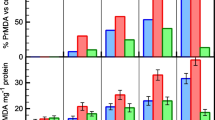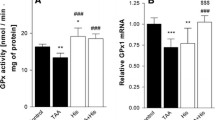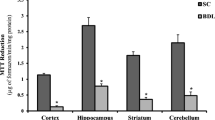Abstract
Hepatic Encephalopathy (HE) is one of the most common complications of acute liver diseases and is known to have profound influence on the brain. Most of the studies, available from the literature are pertaining to whole brain homogenates or mitochondria. Since brain is highly heterogeneous with functions localized in specific areas, the present study was aimed to assess the oxidative stress in different regions of brain-cerebral cortex, cerebellum and pons medulla during acute HE. Acute liver failure was induced in 3-month old adult male Wistar rats by intraperitoneal injection of thioacetamide (300 mg/kg body weight for two days), a well known hepatotoxin. Oxidative stress conditions were assessed by free radical production, lipid peroxidation, nitric oxide levels, GSH/GSSG ratio and antioxidant enzyme machinery in three distinct structures of rat brain-cerebral cortex, cerebellum and pons medulla. Results of the present study indicate a significant increase in malondialdehyde (MDA) levels, reactive oxygen species (ROS), total nitric oxide levels [(NO) estimated by measuring (nitrites + nitrates)] and a decrease in GSH/GSSG ratio in all the regions of brain. There was also a marked decrease in the activity of the antioxidant enzymes-glutathione peroxidase, glutathione reductase and catalase while the super oxide dismutase activity (SOD) increased. However, the present study also revealed that pons medulla and cerebral cortex were more susceptible to oxidative stress than cerebellum. The increased vulnerability to oxidative stress in pons medulla could be due to the increased NO levels and increased activity of SOD and decreased glutathione peroxidase and glutathione reductase activities. In summary, the present study revealed that oxidative stress prevails in different cerebral regions analyzed during thioacetamide-induced acute liver failure with more pronounced effects on pons medulla and cerebral cortex.








Similar content being viewed by others
References
Dawson TM, Synder SH (1994) Gases as biological messengers: nitric oxide and carbon monoxide in the brain. J Neurosci 14:5147–5159
Robberecht W (2000) Oxidative stress in amyotrophic lateral sclerosis. J Neurol Suppl 1:I1–6
Richardson SJ (1993) Free radicals in the genesis of Alzheimer’s disease. Ann NY Acad Sci 695:73–76
Ben-Shachar D, Riederer P (1991) Iron-melanin interaction and lipid peroxidation: implication for Parkinson’s disease. J Neurochem 57:1609–1614
Braughler JM, Hall ED (1989) Central nervous system trauma and stroke. Biochemical considerations for oxygen radicals formation and lipid peroxidation. J Free Radical Biol Med 6:289–301
Ames BN, Shigenaga MK, Hagen TM (1993) Oxidants, antioxidants and the degenerative diseases of aging. Proc Natl Acad Sci 90:7915–7922
Reiter RJ (1995) Oxidative processes and antioxidant defense mechanisms in the ageing brain. FASEB J 9:526–533
Manoli L, Gamaro GD, Silveira PP, Dalmaz C (2000) Effect of chronic variate stress on TBARS and on total radical trapping potential in distinct regions of brain. Neurochem Res 25:915–921
Smythies J (1999) The neurotoxicity of glutamate, dopamine, iron and reactive oxygen species: functional interrelationship in health and diseases. Neurotox Res 1:27–29
Choi JH, Yu BP (1995) Brain synaptosomal ageing: free radicals and membrane fluidity. Free Radical BiolMed 18:133–139
Halliwell B, Gutteridge JMC (1985) Oxygen radicals and the nervous system. Trends Neurosci 8:22–26
Halliwell B (1992) Reactive oxygen species and the central nervous system. J Neurochem 59:1609–1623
Reznick AZ, Packer AL (1993) Free radicals and antioxidants in muscular neurological disease and disorders. In: Poli G, Albano E, Dianzani MU (eds) Free radicals: from basic science to medicine. Birkhauser Verlag, Basel, pp 425–437
Hill JM, Switzer RC (1984) The regional distribution and cellular localization of iron in the rat brain. Neuroscience 11:595–603
Riordan MS, Williams R (2000) Fulminant hepatic failure: a century of Progress. Clin Liver Dis 4:25–45
Blei AT (2005) The pathophysiology of brain edema in acute liver failure. Neurochem Int 47:71–77
Jalan R, Shawcross D, Davies N (2003) The molecular pathogenesis of hepatic encephalopathy. Int J Biochem Cell Biol 35:1175–1181
Norenberg DM (2003) Oxidative stress and Nitrosative stress in ammonia neurotoxicity. Hepatology 37(2):244–247
Reddy PVB, Murthy Ch RK, Reddanna P (2004) Fulminant hepatic failure induced oxidative stress in non-synaptic mitochondria of cerebral cortex in rats. Neurosci Lett 368:15–20
Kosenko E, Kaminsky Y, Lopata O, Muravyov N, Kaminsky A, Hermenegildo C, Felipo V (1998) Nitroarginine, an inhibitor of nitric oxide synthase, prevents changes in super oxide radical and antioxidant enzymes induced by ammonia intoxication. Metabol Brain Dis 13:29–41
Swapna I, SathyaSaiKumar KV, Reddy PVB, Reddanna P, Murthy ChRK, Senthilkumaran B (2006) Phospholipids and cholesterol alterations accompany structural disarray in myelin membrane of rats with hepatic encephalopathy induced by thioacetamide. Neurochem Int 49:238–244
Norton NS, McConnell JR, Rodriguez-Sierra JF (1997) Behavioral and physiological sex differences observed in an animal model of fulminant hepatic failure. Physiol Behav 62: 1113–1124
Rahman TM, Hodgson HJF (2003) The effects of early and late administration of inducible nitric oxide synthatase in a thioacetamide induced model of acute hepatic failure in the rat. J Hepatol 38:583–590
Gellar D (1998) A rat model of hepatic encephalopathy due to fulminant hepatic failure: the role of supportive therapy. In: Soeters PB, Wilson JHP, Meijer AJ, Holm E (eds) Advances in ammonia metabolism and hepatic encephalopathy. Elsevier Science Publishers, Amsterdam, pp 213–217
Muriel P, Alba N, Perez-Alvarez VM, Shibayama M, Tsutsumi VK (2001) Kupffer cells inhibition prevents hepatic lipid peroxidation and damage induced by carbon tetrachloride. Comp Biochem Physiol Part C 130:219–226
Montoliu C, Valles S, Renau-Piqueras J, Guerri C (1994) Ethanol-induced oxygen radical formation and lipid peroxidation in rat brain: effect of chronic alcohol consumption. J Neurochem 63:1855–1862
Sastry KVH, Moudgal RP, Mohan J, Tyagi TS, Rao GS (2002) Spectrophotometric determination of serum nitrites and nitrates by copper-cadmium alloy. Anal Biochem 306:79–82
Bradford M (1976) A rapid and sensitive method for the quantification of microgram quantities of protein utilizing the principle of protein-dye binding. Anal Biochem 72:248–254
Paglia DL, Valentine WN (1967) Studies on qualitative and quantitative characterization of erythrocyte glutathione peroxidase. J Lab Clin Med 70:158–169
Claiborne A (1985) Catalase. In: Greenwald R. (eds) Handbook of methods for oxygen radical research. CRC Press, New York, pp 283–284
Carlberg I, Mannervick B (1975) Purification and characterization of the flavor enzyme glutathione reductase from rat liver. J Biol Chem 250:5474–5480
Bay B-H, Lee Y-K, Tan BK-H, Ling E-A (1999) Lipid peroxidative stress and anti-oxidative enzymes in brains of milk-supplemented rats. Neurosci Lett 277:127–130
Hissin PJ, Hilf R (1976) A fluorometric method for determination of oxidized and reduced glutathione in tissues. Anal Biochem 74:214–226
Kosenko E, Venediktova N, Kaminsky Y, Montoliu C, Felipo V (2003) Sources of oxygen radicals in brain in acute ammonia intoxication in vivo. Brain Res 981:193–200
Kikugawa K, Oikawa N, Miyazawa A, Shindo K, Kato T (2005) Interaction of nitric oxide with glutathione or cysteine generates reactive oxygen species causing DNA single strand breaks. Biol Pharm Bull 28:998–1003
Schliess F, Gorg B, Fischer R, Desjardins P, Bidmon HJ, Hermann A, Butterworth RF, Zilles K, Haussinger D (2002) Ammonia induces MK-801 sensitive nitration and phosphorylation of protein tyrosine residues in rat astrocytes. FASEB J 16:739–741
Hilgier W, Anderzhanova E, Oja SS, Saransaari P, Albrecht J (2003) Taurine reduces ammonia and N-methyl-d-aspartate-induced accumulation of cyclic GMP and hydroxyl radicals in microdialysate of the rat striatum. Eur J Pharmacol 468:21–25
Wang JH, Redmond HP, Wu QD, Bouchier HD (1998) Nitric oxide mediates hepatocytes injury. Am J Physiol 275:1117–1126
Malcolm C, Grieve A, Ritchie L, Schousboe A, Griffiths R (1996) NMDA receptor-mediated cGMP synthesis in primary cultures of mouse cerebellar granule cells appears to involve neuron-astrocyte communication with NO operating as the intracellular messenger. J Neurosci Res 45:129–142
Murthy ChRK, Bender AS, Dombro RS, Bai G, Norenberg MD (2000) Elevation of glutathione levels by ammonium ions in primary cultures of rat astrocytes. Neurochem Int 37:255–268
Lu SC, Huang ZZ, Yang H, Tsukamoto H (1999) Effect of thioacetamide on the hepatic expression of gamma-glutamylcysteine synthatase subunits in the rat. Toxicol Appl Pharmacol 159:161–168
Arivazhagan P, Shila S, Kumaran S, Panneerselvam C (2002) Effect of DL-alpha lipoic acid on the status of lipid peroxidation and antioxidant enzymes in various brain regions of rats. Exp Gerontol 37:803–811
Dogru-Abbasoglu S, Kanbagli O, Balkan J, Cevikbas U, Aykac-Toker G, Uysal M (2001) The protective effect of taurine against thioacetamide hepatotoxicity of rats. Hum Exp Toxicol 20:23–27
Mandavilli BS, Rao KS (1996) Neurons in the cerebral cortex are more susceptible to DNA-damage in ageing rat brain. Biochem Mol Biol Int 40:507–514
Acknowledgments
The work was supported by Grant-in-Aid to Late Prof. Ch.R.K. Murthy from Council of Scientific and Industrial Research (CSIR, 37 (1084)/01/EMR-II), New Delhi, India. KVSSK, IS, PVBR thank Council of Scientific and Industrial Research, New Delhi, India for providing fellowships. We would like to thank the Central Instrumentation Laboratory, University of Hyderabad, for providing access to spectrofluorimetry.
Author information
Authors and Affiliations
Corresponding author
Additional information
Murthy Ch.R.K—Deceased while in service.
Rights and permissions
About this article
Cite this article
Sathyasaikumar, K.V., Swapna, I., Reddy, P.V.B. et al. Fulminant Hepatic Failure in Rats Induces Oxidative Stress Differentially in Cerebral Cortex, Cerebellum and Pons Medulla. Neurochem Res 32, 517–524 (2007). https://doi.org/10.1007/s11064-006-9265-x
Received:
Accepted:
Published:
Issue Date:
DOI: https://doi.org/10.1007/s11064-006-9265-x




